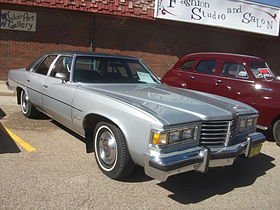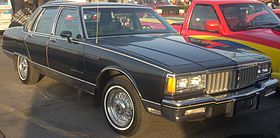Pontiac Parisienne
| Pontiac Parisienne Pontiac Grande Parisienne |
|
|---|---|

1968 Pontiac Parisienne Sport Sedan
|
|
| Overview | |
| Manufacturer | Pontiac (General Motors) |
| Production | 1959–1987 |
| Assembly |
Oshawa Car Assembly, Oshawa, Ontario, Canada Australia |
| Body and chassis | |
| Class | Full-size car |
| Layout | FR layout |
| Chronology | |
| Predecessor |
Pontiac Catalina (For U.S.) Pontiac Bonneville (original full-size model) |
| First generation | |
|---|---|

1959 Pontiac Parisienne
|
|
| Overview | |
| Model years | 1959–60 |
| Body and chassis | |
| Body style | 2-door convertible 2-door coupe 4-door sedan 4-door station wagon |
| Powertrain | |
| Engine | 261 cu in (4.3 L) I6 283 cu in (4.6 L) V8 348 cu in (5.7 L) V8 |
| Transmission | 2-speed automatic 3-speed automatic 3-speed manual 4-speed manual |
| Second generation | |
|---|---|

1961 Pontiac Parisienne sedan
|
|
| Overview | |
| Model years | 1961–1964 |
| Assembly |
Oshawa Car Assembly , Oshawa, Ontario , Canada, Australia |
| Body and chassis | |
| Body style | 2-door convertible 2-door coupe 4-door sedan 4-door hardtop 4-door station wagon |
| Platform | B-body |
| Related |
Buick LeSabre Chevrolet Bel Air Chevrolet Impala Pontiac Catalina/Laurentian |
| Powertrain | |
| Engine | 261 cu in (4.3 L) I6 230 cu in (3.8 L) I6 283 cu in (4.6 L) V8 327 cu in (5.4 L) V8 348 cu in (5.7 L) V8 409 cu in (6.7 L) V8 |
| Transmission | 2-speed automatic 3-speed automatic 3-speed manual 4-speed manual |
| Dimensions | |
| Wheelbase | 119.0 in (3,023 mm) |
| Third generation | |
|---|---|

1968 Pontiac Grande Parisienne Sport Sedan
|
|
| Overview | |
| Model years | 1965–1970 |
| Assembly |
Oshawa Car Assembly , Oshawa, Ontario , Canada, Australia |
| Body and chassis | |
| Body style | 2-door convertible 2-door coupe 4-door sedan 4-door hardtop 4-door station wagon |
| Platform | B-body |
| Related |
Buick LeSabre Chevrolet Bel Air Chevrolet Caprice Chevrolet Impala Pontiac Catalina/Laurentian |
| Powertrain | |
| Engine | 283 cu in (4.6 L) V8 327 cu in (5.4 L) V8 350 cu in (5.7 L) V8 396 cu in (6.5 L) V8 427 cu in (7.0 L) V8 454 cu in (7.4 L) V8 (replaced 427 in 1970) |
| Transmission | 2-speed automatic 3-speed automatic 3-speed manual 4-speed manual |
| Dimensions | |
| Wheelbase | 119.0 in (3,023 mm) 121.0 in (3,073 mm) for Parisienne |
| Fourth generation | |
|---|---|

1976 Pontiac Parisienne Sedan
|
|
| Overview | |
| Model years | 1971–1976 |
| Body and chassis | |
| Body style | 4-door hardtop 2-door coupe 4-door sedan |
| Platform | B-body |
| Related |
Buick LeSabre Chevrolet Bel Air Chevrolet Caprice Chevrolet Impala Oldsmobile 88 Pontiac Catalina/Laurentian |
| Powertrain | |
| Engine | 455 cu in (7.5 L) V8 400 cu in (6.6 L) V8 |
| Dimensions | |
| Wheelbase | 123.4 in (3,134 mm) |
| Fifth generation | |
|---|---|

1984-86 Pontiac Parisienne Sedan
|
|
| Overview | |
| Model years | 1977–1986 |
| Body and chassis | |
| Body style | 2-door coupe 4-door sedan 4-door station wagon |
| Platform | B-body |
| Related |
Buick LeSabre Chevrolet Caprice Chevrolet Impala Oldsmobile 88 Pontiac Catalina/Laurentian |
| Powertrain | |
| Engine | 231 cu in (3.8 L) Buick V6 265 cu in (4.3 L) Pontiac V8 301 cu in (4.9 L) Pontiac V8 305 cu in (5.0 L) Chevrolet V8 350 cu in (5.7 L) Pontiac V8 350 cu in (5.7 L) Oldsmobile Diesel V8 400 cu in (6.6 L) Pontiac |
| Dimensions | |
| Wheelbase | 116.0 in (2,946 mm) |
The Pontiac Parisienne is a full-size rear-wheel drive vehicle that was sold by Pontiac on the GM B platform in Canada from 1958 to 1986 and in the United States from 1983 to 1986. The Parisienne wagon continued under the Safari nameplate until 1989.
The Parisienne entered the production lineup as a sub-series within the Laurentian line in the 1958 model year. Parisienne became a separate model in 1959.
For most of its life, the Parisienne was the Canadian nameplate for the top-of-the-line model sold in GM of Canada's Pontiac showrooms. Parisiennes were distinct from other Canadian Pontiac models by their standard features: the luxuriousness of upholstery fabrics; standard equipment such as courtesy interior and trunk lights; bright trim mouldings in the interior; distinct exterior accent chrome pieces; and availability of two- and four-door hardtops and convertibles.
In particular, Canadian "full size" Pontiacs were actually closely related to Chevrolets, making use of the economical Chevrolet chassis and drivetrain, though with the American Pontiac-styled exterior body panels (They weren't the same as U.S. Pontiac panels since they had to fit the shorter-wheelbase 119-inch Chevrolet "X" frame. U.S. Pontiacs used a full perimeter frame.) and interior instrument panels. As Chevrolets under the skin, Canadian Pontiacs including the Parisienne used the same engines and transmissions as full-size Chevys, including the 230 and 250 cubic inch 6 cylinder and 283, 307, 327, 350, 396, 400, 409, 427 and 454 cu inch V8s. These engines were mated to the same transmissions as Chevrolet, including 3 and 4 speed manual and the 2 speed Powerglide and later the three-speed Turbo-Hydramatic automatic transmissions.
The first Parisienne, offered for the 1958 model year, was a super deluxe "halo" model in the Laurentian line, much like Chevrolet's Bel Air Impala of the same year. Chevrolet's Ramjet fuel injection system, introduced in 1957 in the U.S., was a Parisienne option as well. It was marketed as the "Power Chief" option, but it was identical to Chevy's Ramjet. Also available for the first year Parisienne was Chevrolet's Turboglide automatic transmission.
Built in the same GM of Canada assembly plant in Oshawa, Ontario, Pontiacs had parallel model lineups as "full size" Chevrolets: the Pontiac "Strato Chief" had similar trim level and upholstery as Chevrolet's "Biscayne", the "Laurentian" matched the trim level of the Chevrolet "Bel Air" and while the Parisienne offered similar amenities as Chevrolet's "Impala", the Pontiac version had unique and more costly upholstery fabrics, and beginning in 1964 the "Custom Sport" (later rebadged the "2+2") two-door hardtop and convertible model line was in lock-step with Chevrolet's "Super Sport". Finally, starting in 1966 Pontiac offered the "Grande Parisienne", a two-door and four-door hardtop models parallel to Chevrolet's luxurious "Caprice," although Grande Parisiennes through 1968 used the styling of the US-market Grand Prix. Though most of its life, the Parisienne resembled the US-market Bonneville despite its Chevrolet underpinnings.
...
Wikipedia
